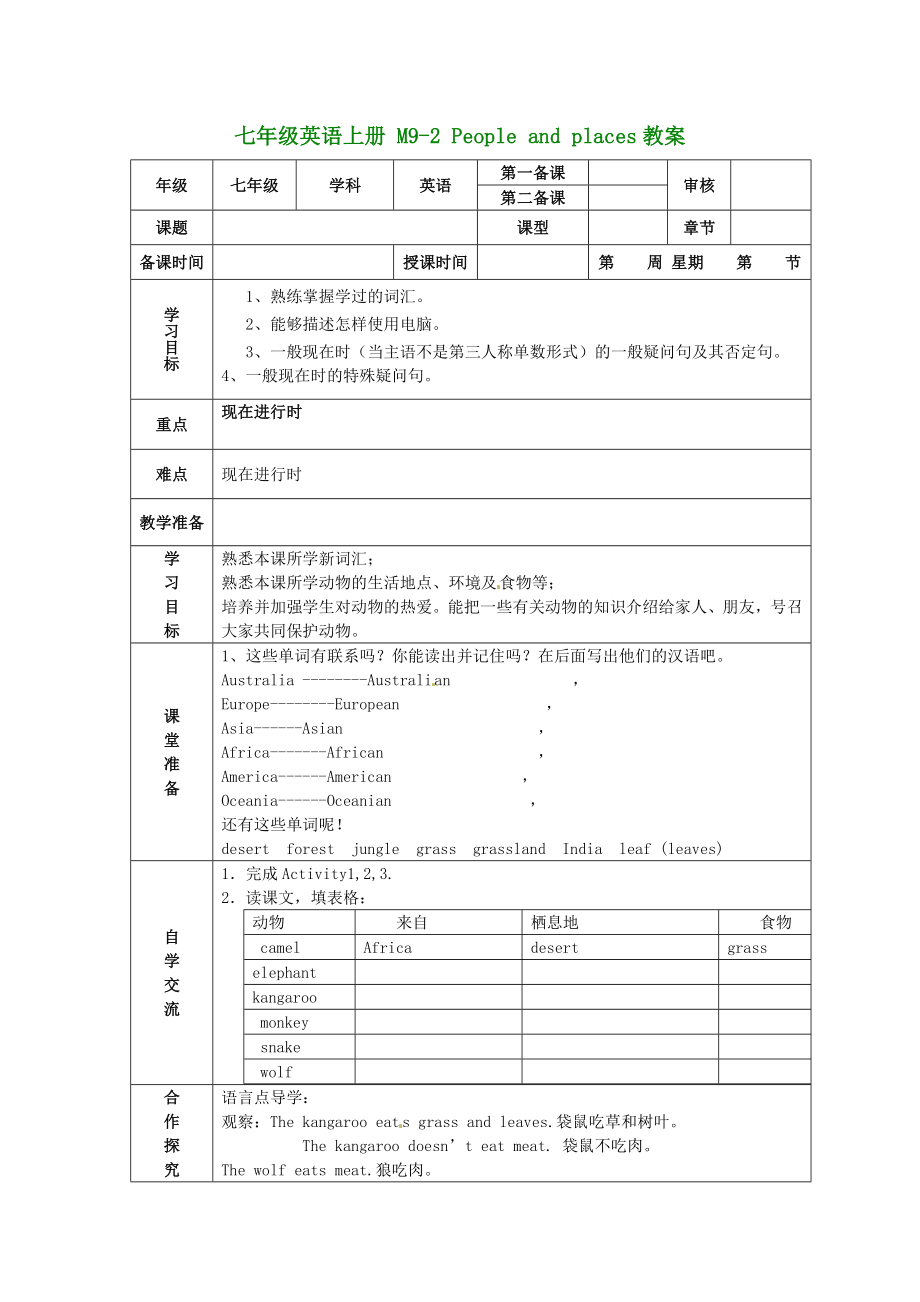《(新版)外研版七年級(jí)英語(yǔ)上冊(cè) M9-2 People and places教案》由會(huì)員分享����,可在線閱讀,更多相關(guān)《(新版)外研版七年級(jí)英語(yǔ)上冊(cè) M9-2 People and places教案(2頁(yè)珍藏版)》請(qǐng)?jiān)谘b配圖網(wǎng)上搜索�。
1、七年級(jí)英語(yǔ)上冊(cè) M9-2 People and places教案
年級(jí)
七年級(jí)
學(xué)科
英語(yǔ)
第一備課
審核
第二備課
課題
課型
章節(jié)
備課時(shí)間
授課時(shí)間
第 周 星期 第 節(jié)
學(xué)習(xí)目標(biāo)
1��、熟練掌握學(xué)過(guò)的詞匯。
2�����、能夠描述怎樣使用電腦�����。
3��、一般現(xiàn)在時(shí)(當(dāng)主語(yǔ)不是第三人稱單數(shù)形式)的一般疑問(wèn)句及其否定句��。
4����、一般現(xiàn)在時(shí)的特殊疑問(wèn)句。
重點(diǎn)
現(xiàn)在進(jìn)行時(shí)
難點(diǎn)
現(xiàn)在進(jìn)行時(shí)
教學(xué)準(zhǔn)備
學(xué)
習(xí)
目
標(biāo)
熟悉本課所學(xué)新詞匯�;
熟悉本課所學(xué)動(dòng)物的生活地點(diǎn)、環(huán)境及食物等���;
培養(yǎng)并加強(qiáng)學(xué)生
2�����、對(duì)動(dòng)物的熱愛�。能把一些有關(guān)動(dòng)物的知識(shí)介紹給家人、朋友���,號(hào)召大家共同保護(hù)動(dòng)物��。
課
堂
準(zhǔn)
備
1����、這些單詞有聯(lián)系嗎����?你能讀出并記住嗎?在后面寫出他們的漢語(yǔ)吧��。
Australia --------Australian �����,
Europe--------European ���,
Asia------Asian ,
Africa-------African ����,
3�����、
America------American ��,
Oceania------Oceanian ����,
還有這些單詞呢��!
desert forest jungle grass grassland India leaf (leaves)
自
學(xué)
交
流
1.完成Activity1,2,3.
2.讀課文�����,填表格:
動(dòng)物
來(lái)自
棲息地
食物
camel
Africa
desert
grass
elephan
4��、t
kangaroo
monkey
snake
wolf
合
作
探
究
語(yǔ)言點(diǎn)導(dǎo)學(xué):
觀察:The kangaroo eats grass and leaves.袋鼠吃草和樹葉���。
The kangaroo doesn’t eat meat. 袋鼠不吃肉�。
The wolf eats meat.狼吃肉���。
The wolf doesn’t eat vegetable.狼不吃蔬菜��。
2思考:當(dāng)主語(yǔ)是第三人稱單數(shù)時(shí)��,行為動(dòng)詞的一般現(xiàn)在時(shí)否定形式是在行為動(dòng)詞前加____________
5��、____��,原句中的動(dòng)詞的第三人稱單數(shù)形式改成了 ���。
3.當(dāng)堂練習(xí):將下列句子改為否定句
1)Dave plays computer games on Sunday .
______________________________________________
2)She goes to school by bus .
______________________________________________
3)Mary visits the zoo .
________________________________________________
6���、
Lily has a computer at home .
___________________________________________________
4.Passage
讀文章,聽錄音�����,回答下列問(wèn)題:(Activity4)
鞏
固
提
高
拓
展
延
伸
用所給單詞的正確形式填空:
1)This is an (Asia) tiger .
2)The boy is (Africa).
3)This is a (Europe) boy .
4) (Australia) spe
7����、ak English 。
5)— the camel (eat)fruit ? —Yes , it does .
6)The tiger (not eat) grass .
7)Elephants (be) very big animals .
8)Polar bears (not have)very long necks .
9)A camel (not often drink).
10)We (like) the panda .
學(xué)
后
反
思
通過(guò)本課學(xué)習(xí)���,我的問(wèn)題表現(xiàn)在:
 (新版)外研版七年級(jí)英語(yǔ)上冊(cè) M9-2 People and places教案
(新版)外研版七年級(jí)英語(yǔ)上冊(cè) M9-2 People and places教案

